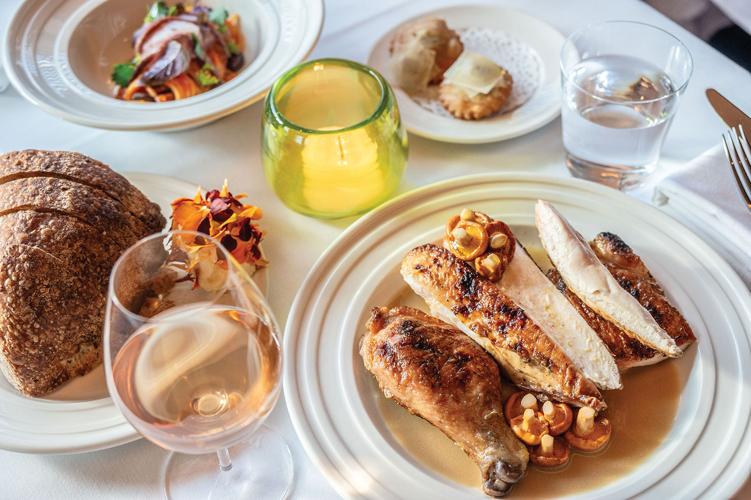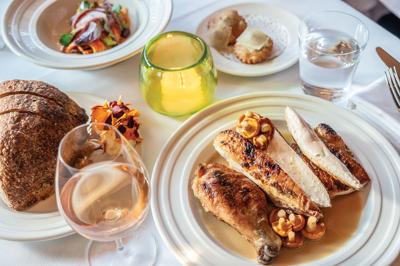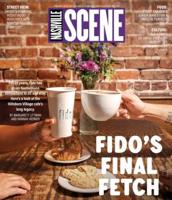Three weeks after dinner at Junior — Philip Krajeck’s thoughtful new restaurant in one section of a former Piggly Wiggly on the rapidly evolving Dickerson Road — I was still thinking of even the smallest elements of the meal. The crunch of the shell of the barbajuan giving way to a whipped puree of nutty futsu squash inside, the sliver of melted tomme brûlée cheese on top and a little pile of halved silky olives. What are those, and where can I get more?
The whisper of floral notes in the blossom butter, strewn with fresh flower petals and creamed with dried specks of the same, to spread on a thick slice of warm, crusty porridge bread (by baker Wesley Barrington), served by the half-loaf.
The discipline and precision of the sliced, minced chives — each teeny hollow circle the same size and no bigger than a pin head — that remained in the pool of sauce under the seared and charred plank of wild cobia. Kudos to whoever stood that day in the kitchen, bent over a cutting board, knife in hand, laser-focused to execute that task.
Those luscious olives again, peeking from the bowl of spaghetti, so irresistible that after we all had a twirl or two, I unabashedly poked the tines of my fork through the remaining thick strands of pasta to find each salty delectable orb, happily spearing an anchovy as well. (The petite Taggiasca olives are grown in the Liguria region of northwestern Italy.)

Tuna belly and sweet pepper spaghetti
No job is too insignificant a contribution or unworthy of 100 percent effort, to the achievement of the whole — that’s the message I observed from all of that.
Which leads to what I believe is the most memorable and impressive dish on the Junior menu — the pâté en croûte. A French classic, its simplest description is a loaf of pâté, bottom and sides wrapped in pastry dough, baked, topped with a layer of gelée, chilled, sliced and served room temperature with some type of condiment.
“The pâté en croûte is a lot of work and takes multiple days,” Krajeck says. “It is all Brian.” (The slice that I … er, we devoured — Iberico pork, chestnuts and mushroom — is also Will Lovell, who cooked at Rolf before leaving to raise 100 percent Iberico hogs at Lovell Farm.)
Brian Mejia is the chef, and like everyone at Junior — front- and back-of-house, except for two dishwashers — he was mined from either Folk or Rolf and Daughters, Krajeck’s two other stellar restaurants. Explaining his decision to open a third, Krajeck says he wanted to give veteran staff opportunities for growth, or simply a new point of view.

Pâté en croûte
Mejia started at Rolf and Daughters in Germantown as a young, curious and hardworking cook whose talent caught Krajeck’s attention. He was there six years before spending time cooking in Mexico City, Paris and, most recently, at Café Frieda in Berlin as chef. He returned to Nashville to open Junior, which leans far more toward France than Italy, though diners will also find touches of Mejia’s Mexican culture in things like the small-bite tostada made with Farm & Sparrow polenta.
Mejia worked closely with Mark Bolton — former chef at Rolf and now culinary director of the trifecta — to develop the Junior menu. Krajeck notes that it is still, and likely will always be, a work in progress.
The basic structure will remain stable, leading with a trio of individual one- or two-bite items — a pristine oyster in mignonette, the barbajuan and tostada, plus the pâté en croute. A quartet of small plates; this is where the pasta, or possibly rice, resides. A green salad of local lettuces and some type of vegetable casserole served in its cooking vessel. On our night, it was fioretto (flowering) cauliflower with a truffle gratin.
Newest project from Folk and Rolf & Daughters chef promises good food, good wine and a good hang
We had two of the three entrée-sized protein plates — recommended for sharing — that claim a section of the menu, and will likely represent fish, fowl and beef. Pork might make an occasional cameo. The fish is likely to change nightly; on our visit, it was that cobia, with a crackly cap, the flesh of the white fish slightly sweet, firm enough to swirl slices through the porcini cream.
The Amish chicken, sometimes listed as golden chicken, is leading the charge to elevate members of the bird family to the vaunted position Krajeck thinks they deserve. “In America, poultry is undervalued,” he says. “But in other countries, the appreciation for great heritage breeds of guinea hens, pullet breast, pigeons and pheasant is very high.”
Prior to opening, Mejia took road trips through Kentucky seeking heritage golden chickens, whose happy, free-range lives account in part for their very high fat content. Before the half-chicken arrives at your table — the breast sliced and dark meat on the bone, glistening with the rich albufera sauce made from rendered fat and broth, piled with whole chanterelle mushrooms — it has also spent several days being prepped.
Though the menu will be malleable, the foundational ethos the food at Junior is built upon does not waver from its reliance and alliance with local agriculture. “You can’t make good food or have a good restaurant without good farms,” Krajeck says. “Small farms go hand-in-hand with small, independent restaurants. They’re symbiotic, they support each other and push each other.”
That devotion to agriculture extends to the wine list, chosen by Billy Smith. The former assistant wine director at The Four Horsemen in Brooklyn was coaxed to relocate to Nashville and take on the lead role for Krajeck’s restaurants, adhering to the same values as the food.
The wine even claims its own station against a far wall, a red lacquered platform set with a bright-green lamp on one corner and gleaming silver bottle bowl on the other; Junior’s elegant stemware is displayed on recessed built-in shelves. That defined space is one of many eye-catching designs and elements that seamlessly form Junior’s refined, sophisticated yet playful interior, by Third Man Records creative director Jordan Williams.

Most compelling is the sculptural ceiling; one side carved inward, the other outward so that if folded together, they would lock into a flat box. The goal — there and throughout the small room — was to avoid direct overhead light. The space’s 50 seats are distributed at the sexy, come-hither main bar, a leather upholstered banquette along one wall and four round tables, placed with a view of the open kitchen. All tables are draped in quality white linen, centered by green glass votives; cutlery and china are weighty and classic. Splashes of brilliant color and arresting graphics pop up in the hall and restrooms. Service was impeccable the night we dined — graceful, assured, informative and respectful of our space.
The room’s aesthetic forms the dazzling first impression of Junior, but the overall feeling that lingers after the experience is one of simple, pure pleasure, derived from all the people — from farm to kitchen to table — who take enormous pride in what they do, and great joy in sharing it.










